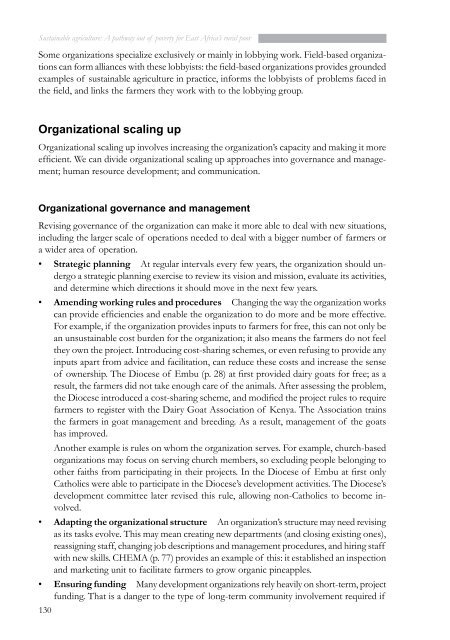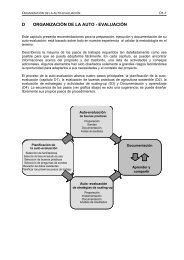cases from tanzania - Sustainet
cases from tanzania - Sustainet
cases from tanzania - Sustainet
Create successful ePaper yourself
Turn your PDF publications into a flip-book with our unique Google optimized e-Paper software.
Sustainable agriculture: A pathway out of poverty for East Africa’s rural poor<br />
Some organizations specialize exclusively or mainly in lobbying work. Field-based organizations<br />
can form alliances with these lobbyists: the field-based organizations provides grounded<br />
examples of sustainable agriculture in practice, informs the lobbyists of problems faced in<br />
the field, and links the farmers they work with to the lobbying group.<br />
organizational scaling up<br />
Organizational scaling up involves increasing the organization’s capacity and making it more<br />
efficient. We can divide organizational scaling up approaches into governance and management;<br />
human resource development; and communication.<br />
organizational governance and management<br />
Revising governance of the organization can make it more able to deal with new situations,<br />
including the larger scale of operations needed to deal with a bigger number of farmers or<br />
a wider area of operation.<br />
• Strategic planning At regular intervals every few years, the organization should undergo<br />
a strategic planning exercise to review its vision and mission, evaluate its activities,<br />
and determine which directions it should move in the next few years.<br />
• Amending working rules and procedures Changing the way the organization works<br />
can provide efficiencies and enable the organization to do more and be more effective.<br />
For example, if the organization provides inputs to farmers for free, this can not only be<br />
an unsustainable cost burden for the organization; it also means the farmers do not feel<br />
they own the project. Introducing cost-sharing schemes, or even refusing to provide any<br />
inputs apart <strong>from</strong> advice and facilitation, can reduce these costs and increase the sense<br />
of ownership. The Diocese of Embu (p. 28) at first provided dairy goats for free; as a<br />
result, the farmers did not take enough care of the animals. After assessing the problem,<br />
the Diocese introduced a cost-sharing scheme, and modified the project rules to require<br />
farmers to register with the Dairy Goat Association of Kenya. The Association trains<br />
the farmers in goat management and breeding. As a result, management of the goats<br />
has improved.<br />
130<br />
Another example is rules on whom the organization serves. For example, church-based<br />
organizations may focus on serving church members, so excluding people belonging to<br />
other faiths <strong>from</strong> participating in their projects. In the Diocese of Embu at first only<br />
Catholics were able to participate in the Diocese’s development activities. The Diocese’s<br />
development committee later revised this rule, allowing non-Catholics to become involved.<br />
• Adapting the organizational structure An organization’s structure may need revising<br />
as its tasks evolve. This may mean creating new departments (and closing existing ones),<br />
reassigning staff, changing job descriptions and management procedures, and hiring staff<br />
with new skills. CHEMA (p. 77) provides an example of this: it established an inspection<br />
and marketing unit to facilitate farmers to grow organic pineapples.<br />
• Ensuring funding Many development organizations rely heavily on short-term, project<br />
funding. That is a danger to the type of long-term community involvement required if




